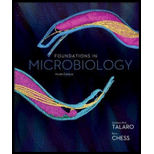
To determine:
How is it possible to find that diseases that are currently thought to be non-infectious will probably be found to be caused by microbes?
Introduction:
Currently there are several non-infectious diseases that are thought to be not caused by microbes. But, in next decade it is quite possible that it will be found out that these diseases have been caused by microbes.
Explanation of Solution
Due to the advent of technologies many techniques have evolved and have been invented that can easily isolate and identify various types of microbes within few hours. These techniques have high accuracy and are very sensitive. The most advanced among them are the genetic techniques, that help in analyzing the genome of an isolated culture. Many new culture techniques and culture media have also been made. Hence, the diagnosis in modern medicine has reached great heights.
Hence, it may be concluded that, the advent in diagnostic techniques has taken modern medicine to such a stage where many non-infectious diseases can be found out to be caused by microbes and genetic techniques especially will help in great way in differentiating and identifying the microbes.
Want to see more full solutions like this?
Chapter 17 Solutions
Foundations in Microbiology: Basic Principles
- Why can't bacteria be harmful?arrow_forwardRefrigerated milk can spoil due to microbial growth. Do these microbes typically cause disease in humans? Consider the environment in your body and the environment in which the microbes are growing.arrow_forwardWhen food leftovers are stored in a refrigerator, how does this help prevent food borne illnesses? Group of answer choices Low temperatures deactivate any toxins that might be produced by microbes. Low temperatures inhibit the metabolism and growth of microbes. Low temperatures disrupt microbe membranes and kill any microbes that are present. Low temperatures prevent microbes from forming biofilms.arrow_forward
- which of the following definitions is not technically correct? a. broad spectrum - effective against many different types of microbes b. bacteriostatic - prevents microbes from growing c. antibiotic - microbial or synthetic product that kills or inhibits growth of microbes. d. all of the above are correctarrow_forwardWhat does it mean to say microbes are ubiquitous?arrow_forwardwhy microbes being small is significant?arrow_forward
- What statement describes the danger of using heavy metals to control microbe growth? Group of answer choices Heavy metals promote biofilm formation in humans. Heavy metals stimulate some microbes to reproduce even more. Heavy metals can assist with virus attachment to host cells. Heavy metals are toxic to many organisms besides microbes.arrow_forwardExplain why many microbes do not cause disease while others doarrow_forwardWhy some diseases are not caused by microorganisms?arrow_forward
- Infectious diseases can be caused and spread by all manner of living and non living things. Which group of microbes seems to be the worst? Why?arrow_forwardWhich statement is NOT a concept in microbes present in animals? A. Each individual animal has its unique set of microbial flora. B. There are normal microbial flora present in key parts of an animal. C. Personal hygiene and decontamination can remove all microbes in an animal. D. Some microbes are incidental and transient.arrow_forwardScientists have cultured bacteria isolated from within frozen mammoths, which are thousands of years old. Why would it not be surprising if these microbes were to show some resistance to modern antimicrobials that didn’t exist when the mammoths died?arrow_forward
 Human Anatomy & Physiology (11th Edition)BiologyISBN:9780134580999Author:Elaine N. Marieb, Katja N. HoehnPublisher:PEARSON
Human Anatomy & Physiology (11th Edition)BiologyISBN:9780134580999Author:Elaine N. Marieb, Katja N. HoehnPublisher:PEARSON Biology 2eBiologyISBN:9781947172517Author:Matthew Douglas, Jung Choi, Mary Ann ClarkPublisher:OpenStax
Biology 2eBiologyISBN:9781947172517Author:Matthew Douglas, Jung Choi, Mary Ann ClarkPublisher:OpenStax Anatomy & PhysiologyBiologyISBN:9781259398629Author:McKinley, Michael P., O'loughlin, Valerie Dean, Bidle, Theresa StouterPublisher:Mcgraw Hill Education,
Anatomy & PhysiologyBiologyISBN:9781259398629Author:McKinley, Michael P., O'loughlin, Valerie Dean, Bidle, Theresa StouterPublisher:Mcgraw Hill Education, Molecular Biology of the Cell (Sixth Edition)BiologyISBN:9780815344322Author:Bruce Alberts, Alexander D. Johnson, Julian Lewis, David Morgan, Martin Raff, Keith Roberts, Peter WalterPublisher:W. W. Norton & Company
Molecular Biology of the Cell (Sixth Edition)BiologyISBN:9780815344322Author:Bruce Alberts, Alexander D. Johnson, Julian Lewis, David Morgan, Martin Raff, Keith Roberts, Peter WalterPublisher:W. W. Norton & Company Laboratory Manual For Human Anatomy & PhysiologyBiologyISBN:9781260159363Author:Martin, Terry R., Prentice-craver, CynthiaPublisher:McGraw-Hill Publishing Co.
Laboratory Manual For Human Anatomy & PhysiologyBiologyISBN:9781260159363Author:Martin, Terry R., Prentice-craver, CynthiaPublisher:McGraw-Hill Publishing Co. Inquiry Into Life (16th Edition)BiologyISBN:9781260231700Author:Sylvia S. Mader, Michael WindelspechtPublisher:McGraw Hill Education
Inquiry Into Life (16th Edition)BiologyISBN:9781260231700Author:Sylvia S. Mader, Michael WindelspechtPublisher:McGraw Hill Education





